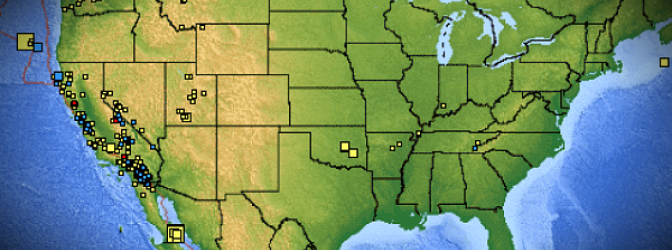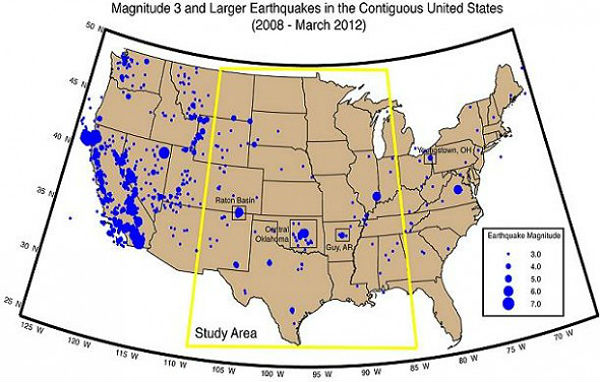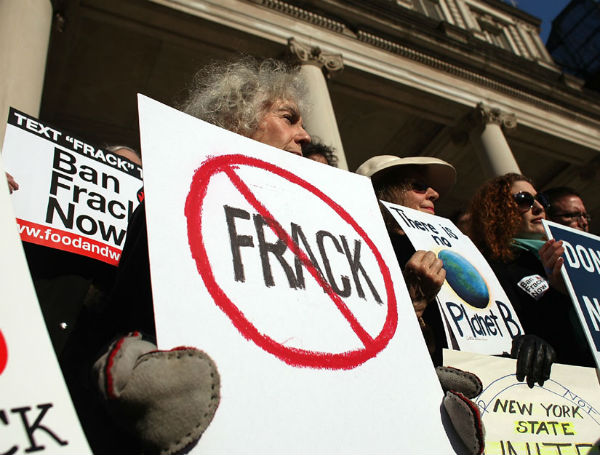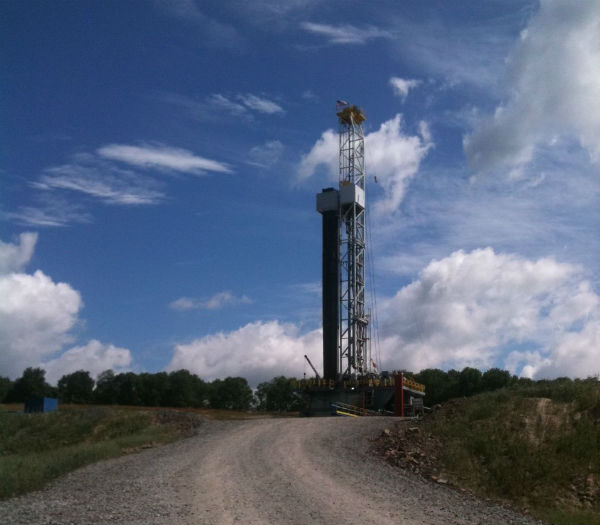
The startling increase in earthquakes across US is
"almost certainly man-made"
Posted by Chillymanjaro on April 18, 2012 in categories Geology, Seismic activity

USGS scientists have been investigating the recent increase in the number of magnitude 3 and greater earthquakes in the midcontinent of the United States. These earthquakes are fairly small – large enough to have been felt by many people, yet small enough to rarely have caused damage. Scientists used ultra-sensitive quake-sensing technology to track mid-western tremors and watched the number of quakes jump from a steady background of 20 tremors a year to 50 in 2009, 87 in 2010 and a whopping 134 last year. Clearly, something strange was going on.
Beginning in 2001, the average number of earthquakes occurring per year of magnitude 3 or greater increased significantly, culminating in a six-fold increase in 2011 over 20th century levels. A team of USGS scientists analyzed changes in the rate of earthquake occurrence in the midcontinent using large USGS databases of earthquakes recorded since 1970. The number of M3 or greater earthquakes increases steadily at about 21 events per year until around 2000, when it increases about 50% to 31 events per year. By 2004, the number increased sharply to about 151 events per year.

The modest increase that began in 2001 is due to increased seismicity in the coal bed methane field of the Raton Basinalong the Colorado-New Mexico border west of Trinidad, CO. The acceleration in activity that began in 2009 appears toinvolve a combination of source regions of oil and gas production, including the Guy, Arkansas region, and in central andsouthern Oklahoma. Oklahoma experienced the largest earthquake in the state history on Nov. of 2011, the quakemeasured 5.6 on the Richter scale and hit outside of Oklahoma City. An LA Times article suggested fracking could havebeen the cause.
The nation’s midsection is typically quiet, geologically speaking. The thick basement rock underlying the U.S. Midwest isfull of faults, just like basement rock everywhere. But earthquakes only happen when something changes the stress regimeenough to unlock those faults. In quake-prone places such as California and Japan, the edges of tectonic plates are shovingpast each other. Near active volcanoes, magma presses on the rocks as it pushes its way up from below.
Man-made earthquakes are real, they are proliferating across the U.S. Midwest, and the oil and gas industry is "almost certainly" responsible. A naturally-occurring rate change of this magnitude is unprecedented outside of volcanic settings orin the absence of a main shock, of which there were neither in the region. That is why USGS team concludes that thestartling increase is "almost certainly man-made.
Gas drilling is on the rise around the country, especially hydraulic fracturing. Hydrofracking uses billions of gallons of watera year to crack deep rock and release natural gas. Some have suspected that fracking was causing quakes, but evidence in Several parts of the country points to wastewater wells, where companies dump used frack water. The culprit ofearthquakes near fracking sites is not believed to be the act of drilling and fracturing the shale itself, but rather the disposalwells.
Hydraulic fracturing or “fracking”
Hydraulic fracturing or “fracking” is a technology used to extract natural gas that lies within a shale rock formation thousands of feet beneath the earth’s surface. Combined with another technique called “horizontal drilling,” natural gas companies are able to drill for previously untapped reserves. Horizontal drilling allows one surface well to tap gas trapped over hundreds of acres. Once the conventional verticle drill hits the shale formation, it turns horizontally in several directions. The well is then cased with steel and cement. Explosives are places at intervals along the horizontal section of the well to perforate the steel casing. Under very high pressure, a combination of water, sand and chemicals is sent deep into the earth to create cracks and fissures in the shale rock. Those fissures are held open by the sand, allowing the natural gas to flow through those cracks, into the well bore and up to the surface.

Industry says the process is safe and does not pollute drinking water supplies. But a growing movement of environmentalists, scientists and residents worry that the chemicals used in the fracking process will leak into aquifers. Wastewater from the process returns to the surface contaminated with some of those chemicals, as well as buried salts and naturally occurring radioactive material. That wastewater needs to be treated, or buried in containment wells.
Click here for explanation of the hydraulic fracturing process
USGS’s studies do not claim that hydraulic fracturing causes the increased rate of earthquakes. USGS’s scientists havefound, however, that at some locations the increase in seismicity coincides with the injection of wastewater in deepdisposal wells. While it appears likely that the observed seismicity rate changes in the middle part of the United States inrecent years are manmade, it remains to be determined if they are related to either changes in production methodologies orto the rate of oil and gas production. Fracking has been linked to everything from polluted water to earthquakes, but therush toward developing the practice hasn't slowed much.

Wastewater disposal wells can induce earthquakes
The fact that the disposal (injection) of wastewater produced while extracting resources has the potential to cause earthquakes has long been known. Wastewater is a byproduct of oil and natural gas production from tight shale formations and coal beds. Generally, wastewater produced from many oil and gas production wells within a field may be injected through a single or just a few disposal wells. Waste wells are often deeper than gas drilling wells, down into basement rock where faults are more common. The high water pressure basically separates a fault that has locked in place; the fault moves and creates a quake.
There are more than 50,000 disposal wells in Texas servicing more than 216,000 active drilling wells, according to the Railroad Commission. Each well uses about 4.5 million gallons of chemical-laced water, according to hydraulicfracturing.com.
In preliminary findings, scientists cite a series of examples for which an uptick in seismic activity is observed in areas where the disposal of wastewater through deep-well injection increased significantly. These areas tend to be in the middle of the country – mostly in Colorado, Texas, Arkansas, Oklahoma and Ohio.
Not all wastewater disposal wells induce earthquakes. Of approximately 150,000 Class II injection wells in the United States, including roughly 40,000 waste fluid disposal wells for oil and gas operations, only a tiny fraction of these disposal wells have induced earthquakes that are large enough to be of concern to the public. Information on wastewater disposal wells and the US Environmental Protection Agency's Underground Injection Control program is available online. Earthquakes induced by fluid-injection activities are not always located close to the point of injection. In some cases, the induced earthquakes have been located as far as 6 miles from the injection well.
One of the earliest documented case histories with a scientific consensus of wastewater inducing earthquakes, is at the Rocky Mountain Arsenal well, near Denver. There, a large volume of wastewater was injected from 1962-1966, inducing a series of earthquakes (below magnitude 5).
Environmentalists have repeatedly pressed regulators to compel oil and gas companies to report what chemicals they use in the drilling and fracking process. Drilling companies add these chemicals to perform particular functions (for example, to prevent corrosion or give the fluid the right consistency), or leave them in because they're too expensive to remove. According to a 2011 congressional report, many of the chemicals used can pose a serious health risk. No one knows the exact makeup of the frack mixture, drilling muds and other stuff used at well sites (which change from well to well), but this list breaks down the main ingredients revealed so far. A full list of chemicals can be found at fracfocus.org, a website dedicated to chemical disclosure. (Find out more here)
FAQs - Earthquakes Induced by Fluid Injection
“And as long as I’m president, we’re going to keep on encouraging oil development and infrastructure, and we’re going to do it in a way that protects the health and safety of the American people,” Barack Obama
Areas of west Texas and eastern New Mexico are experiencing a new energy rush, with prosperity spilling far beyond the oil fields. Fracking requires huge quantities of water, which is hard to come by in the desert. If fracking continues expanding, water experts say aquifers in the desert area could run dry. And that's just one among the litany of concerns.
The Earth’s crust is pervasively fractured at depth by faults. These faults can sustain high stresses without slipping because natural "tectonic" stress and the weight of the overlying rock pushes the opposing sides of the fault together, increasing the frictional resistance to fault slip. The injected wastewater in deep wells can counteract the frictional forces on faults, causing an earthquake.
Tags: DISPOSAL WELL, FRACKING, HYDRAULIC FRACTURING
Related articles
- Fracking flowback could pollute groundwater with heavy metals
The chemical makeup of wastewater generated by “hydrofracking” could cause the release of tiny particles in soils that often strongly bind heavy metals and pollutants, exacerbating the environmental risks during accidental spills, Cornell University research - Massive landslide swept through Mesa County, western Colorado, U.S.
A massive landslide swept through Mesa County in western Colorado, U.S., on May 25, 2014. According to the Mesa County Sheriff's Department, three people are missing. The slide occurred after a day of rain and a smaller slide earlier in a day. Acc - 2011 Oklahoma human induced earthquake may have triggered larger quake - study
In a new study involving researchers at the U.S. Geological Survey, scientists observed that a human-induced magnitude 5.0 earthquake near Prague, Oklahoma in November 2011 may have triggered the larger M 5.7 earthquake less than a day later. This research - Colorado approves new regulations to limit air pollution from oil and gas drilling
Colorado [USA] health and environment officials approved this week a set of new rules to limit air pollution from oil and gas drilling in the state, along with nation's first plan to detect and reduce methane emissions. The - Earthquake hazard in Oklahoma increased due to ongoing swarm
USGS reported today that since January 2009, more than 200 magnitude 3.0 or greater earthquakes have rattled Central Oklahoma, which marked a significant rise in the frequency of these seismic events. Important to people living in the Oklahoma City region
Pingbacks & trackbacks
- Quivering Heart | Dr. Sircus
- Fracking responsible for water contamination across US | 2012 The Awakening
- Quivering Heart | Dr. Mark's Blog
- The Watchers - UK will allow shale gas fracking despite earthquake connections?
